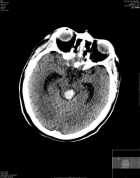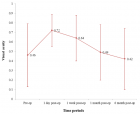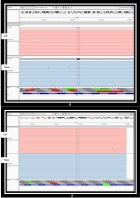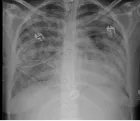Abstract
Short Communication
Function Prediction of Proteins from their Sequences with BAR 3.0
Giuseppe Profiti, Pier Luigi Martelli and Rita Casadio*
Published: 23 June, 2017 | Volume 1 - Issue 1 | Pages: 001-005
Protein functional annotation requires time and effort, while sequencing technologies are fast and cheap. For this reason, the development of software tools aimed at predicting protein function from sequences can help in protein annotation.
In this paper, we describe how to use our recently implemented Bologna Annotation Resource (BAR) version 3.0, a tool based on over 30 million protein sequences for protein structural and functional annotation. In BAR 3.0, sequences are arranged in a similarity graph and then clustered together when they share at least 40% sequence identity over 90% of sequence alignment, for a total of 1,361,773 clusters.
Protein sequences with known function transfer their annotation to other sequences in the same cluster after statistical validation. Sequences with unknown function and new sequences entering in a cluster inherit its statistically validated annotations.
The method well compares to other techniques in the Critical Assessment of protein Function Annotation algorithms (CAFA). The CAFA experiment tests the performances of different predictors on a dataset that accumulates annotations over time. BAR predictions have been submitted to all the instances of CAFA through the years (BAR Plus in CAFA, BAR++ in CAFA2 and BAR 3.0 in CAFA3). The benchmarking indicates that in the field improvement is still possible and that our BAR scores among the top performing methods.
This work focuses on how the tool can transfer statistically significant features to poorly annotated or new sequences derived from transcrptomics or proteomics experiments.
Read Full Article HTML DOI: 10.29328/journal.hpbr.1001001 Cite this Article Read Full Article PDF
References
- UniProt Consortium. UniProt: A hub for protein information. Nucleic Acids Res. 2015; 43: 204-212. Ref.: https://goo.gl/YrmgUA
- Radivojac P, Clark WT, Oron TR, Schnoes AM, Wittkop T, et al. A large-scale evaluation of computational protein function prediction. Nat Meth. 2013; 10: 221-227. Ref.: https://goo.gl/Xg6dfK
- Jiang Y, Oron RT, Clark TW, Bankapur RA, D’Andrea D, et al. An expanded evaluation of protein function prediction methods shows an improvement in accuracy. Genome Biology. 2016; 17: 184. Ref.: https://goo.gl/LQhGpN
- Bartoli L, Montanucci L, Fronza R, Martelli PL, Fariselli P, et al. The Bologna annotation resource: a non hierarchical method for the functional and structural annotation of protein sequences relying on a comparative large-scale genome analysis. J Proteome Res. 2009; 8: 4362-4371. Ref.: https://goo.gl/DLrVmk
- Piovesan D, Martelli PL, Fariselli P, Zauli A, Rossi I, et al. BAR-PLUS: the Bologna Annotation Resource Plus for functional and structural annotation of protein sequences. Nucleic Acids Res. 2011; 39: 197-202. Ref.: https://goo.gl/9it5MU
- Piovesan D, Martelli PL, Fariselli P, Profiti G, Zauli A, et al. How to inherit statistically validated annotation within BAR+ protein clusters. BMC Bioinformatics. 2013; 3: 4. Ref.: https://goo.gl/ZM9Buz
- Profiti G, Martelli PL, Casadio R. The Bologna Annotation Resource (BAR 3.0): improving protein functional annotation. Nucl Acids Res. 2017. Ref.: https://goo.gl/gvWSiw
- Gene Ontology Consortium. Gene Ontology Consortium: going forward. Nucleic Acids Res. 2015; 43: 1049-1056. Ref.: https://goo.gl/kW74s7
- Finn RD, Coggill P, Eberhardt RY, Eddy SR, Mistry J, et al. The Pfam protein families database: towards a more sustainable future. Nucleic Acids Res. 2016; 44: 279-285. Ref.: https://goo.gl/AVdLFi
- Rose PW, Prlic A, Bi C, Bluhm WF, Christie CH, et al. The RCSB Protein Data Bank: views of structural biology for basic and applied research and education. Nucleic Acids Res. 2015; 43: 345-356. Ref.: https://goo.gl/Az5RMF
- Kanehisa M, Furumichi M, Tanabe M, Sato Y, Morishima K. KEGG: New perspectives on genomes, pathways, diseases and drugs. Nucleic Acids Res. 2017; 45: 353-361. Ref.: https://goo.gl/zQm1iq
- Orchard S, Ammari M, Aranda B, Breuza L, Briganti L, et al. The MIntAct project-IntAct as a common curation platform for 11 molecular interaction databases. Nucl Acids Res. 2014; 42: 358-363. Ref.: https://goo.gl/gWJfTW
Figures:
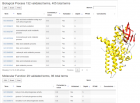
Figure 1
Similar Articles
-
Function Prediction of Proteins from their Sequences with BAR 3.0Giuseppe Profiti,Pier Luigi Martelli,Rita Casadio*. Function Prediction of Proteins from their Sequences with BAR 3.0. . 2017 doi: 10.29328/journal.hpbr.1001001; 1: 001-005
-
Microarray Analysis of Fish Genomic Data for enhancing Aquaculture Productivity of IndiaAjit Kumar Roy*. Microarray Analysis of Fish Genomic Data for enhancing Aquaculture Productivity of India. . 2017 doi: 10.29328/journal.hpbr.1001002; 1: 006-017
-
In silico analysis and characterization of fresh water fish ATPases and homology modellingRumpi Ghosh,AD Upadhayay,AK Roy*. In silico analysis and characterization of fresh water fish ATPases and homology modelling. . 2017 doi: 10.29328/journal.hpbr.1001003; 1: 018-024
-
The bio-energy transport in the protein molecules and its experimental validations of correctnessPang Xiao-Feng*. The bio-energy transport in the protein molecules and its experimental validations of correctness. . 2018 doi: 10.29328/journal.apb.1001004; 2: 001-048
-
Prediction of protein Post-Translational Modification sites: An overviewMd. Mehedi Hasan*,Mst. Shamima Khatun. Prediction of protein Post-Translational Modification sites: An overview. . 2018 doi: 10.29328/journal.apb.1001005; 2: 049-057
-
The properties of nonlinear excitations and verification of validity of theory of energy transport in the protein moleculesPang Xiao-Feng*. The properties of nonlinear excitations and verification of validity of theory of energy transport in the protein molecules. . 2018 doi: 10.29328/journal.apb.1001006; 2: 058-108
-
Theoretical study on binding interactions of laccase-enzyme from Ganoderma weberianum with multiples ligand substrates with environmental impactYosberto Cárdenas-Moreno*,Luis Ariel Espinosa,Julio Cesar Vieyto,Michael González-Durruthy,Alberto del Monte-Martinez,Gilda Guerra-Rivera,Maria Isabel Sánchez López. Theoretical study on binding interactions of laccase-enzyme from Ganoderma weberianum with multiples ligand substrates with environmental impact. . 2019 doi: 10.29328/journal.apb.1001007; 3: 001-009
-
The importance of gestational age in first trimester, maternal urine MALDI-Tof MS screening tests for Down SyndromeRay K Iles*,Nicolaides K,Pais RJ,Zmuidinaite R,Keshavarz S,Poon LCY,Butler SA. The importance of gestational age in first trimester, maternal urine MALDI-Tof MS screening tests for Down Syndrome. . 2019 doi: 10.29328/journal.apb.1001008; 3: 010-017
-
Classification of diseases using a hybrid fuzzy mutual information technique with binary bat algorithmFiras Ahmed Yonis AL-Taie*,Omar Saber Qasim . Classification of diseases using a hybrid fuzzy mutual information technique with binary bat algorithm. . 2020 doi: 10.29328/journal.apb.1001009; 4: 001-005
-
Improving cancer diseases classification using a hybrid filter and wrapper feature subset selectionNoor Muhammed Noori*,Omar Saber Qasim. Improving cancer diseases classification using a hybrid filter and wrapper feature subset selection. . 2020 doi: 10.29328/journal.apb.1001010; 4: 006-011
Recently Viewed
-
Prediction of neonatal and maternal index based on development and population indicators: a global ecological studySedigheh Abdollahpour,Hamid Heidarian Miri,Talat Khadivzadeh*. Prediction of neonatal and maternal index based on development and population indicators: a global ecological study. Clin J Obstet Gynecol. 2021: doi: 10.29328/journal.cjog.1001096; 4: 101-105
-
A Genetic study in assisted reproduction and the risk of congenital anomaliesKaparelioti Chrysoula,Koniari Eleni*,Efthymiou Vasiliki,Loutradis Dimitrios,Chrousos George,Fryssira Eleni. A Genetic study in assisted reproduction and the risk of congenital anomalies. Clin J Obstet Gynecol. 2021: doi: 10.29328/journal.cjog.1001095; 4: 096-100
-
Leiomyosarcoma in pregnancy: Incidental finding during routine caesarean sectionToon Wen Tang*,Phoon Wai Leng Jessie. Leiomyosarcoma in pregnancy: Incidental finding during routine caesarean section. Clin J Obstet Gynecol. 2021: doi: 10.29328/journal.cjog.1001094; 4: 092-095
-
Adult Neurogenesis: A Review of Current Perspectives and Implications for Neuroscience ResearchAlex, Gideon S*,Olanrewaju Oluwaseun Oke,Joy Wilberforce Ekokojde,Tolulope Judah Gbayisomore,Martina C. Anene-Ogbe,Farounbi Glory,Joshua Ayodele Yusuf. Adult Neurogenesis: A Review of Current Perspectives and Implications for Neuroscience Research. J Neurosci Neurol Disord. 2024: doi: 10.29328/journal.jnnd.1001102; 8: 106-114
-
Late discover of a traumatic cardiac injury: Case reportBenlafqih C,Bouhdadi H*,Bakkali A,Rhissassi J,Sayah R,Laaroussi M. Late discover of a traumatic cardiac injury: Case report. J Cardiol Cardiovasc Med. 2019: doi: 10.29328/journal.jccm.1001048; 4: 100-102
Most Viewed
-
Evaluation of Biostimulants Based on Recovered Protein Hydrolysates from Animal By-products as Plant Growth EnhancersH Pérez-Aguilar*, M Lacruz-Asaro, F Arán-Ais. Evaluation of Biostimulants Based on Recovered Protein Hydrolysates from Animal By-products as Plant Growth Enhancers. J Plant Sci Phytopathol. 2023 doi: 10.29328/journal.jpsp.1001104; 7: 042-047
-
Sinonasal Myxoma Extending into the Orbit in a 4-Year Old: A Case PresentationJulian A Purrinos*, Ramzi Younis. Sinonasal Myxoma Extending into the Orbit in a 4-Year Old: A Case Presentation. Arch Case Rep. 2024 doi: 10.29328/journal.acr.1001099; 8: 075-077
-
Feasibility study of magnetic sensing for detecting single-neuron action potentialsDenis Tonini,Kai Wu,Renata Saha,Jian-Ping Wang*. Feasibility study of magnetic sensing for detecting single-neuron action potentials. Ann Biomed Sci Eng. 2022 doi: 10.29328/journal.abse.1001018; 6: 019-029
-
Pediatric Dysgerminoma: Unveiling a Rare Ovarian TumorFaten Limaiem*, Khalil Saffar, Ahmed Halouani. Pediatric Dysgerminoma: Unveiling a Rare Ovarian Tumor. Arch Case Rep. 2024 doi: 10.29328/journal.acr.1001087; 8: 010-013
-
Physical activity can change the physiological and psychological circumstances during COVID-19 pandemic: A narrative reviewKhashayar Maroufi*. Physical activity can change the physiological and psychological circumstances during COVID-19 pandemic: A narrative review. J Sports Med Ther. 2021 doi: 10.29328/journal.jsmt.1001051; 6: 001-007

HSPI: We're glad you're here. Please click "create a new Query" if you are a new visitor to our website and need further information from us.
If you are already a member of our network and need to keep track of any developments regarding a question you have already submitted, click "take me to my Query."









